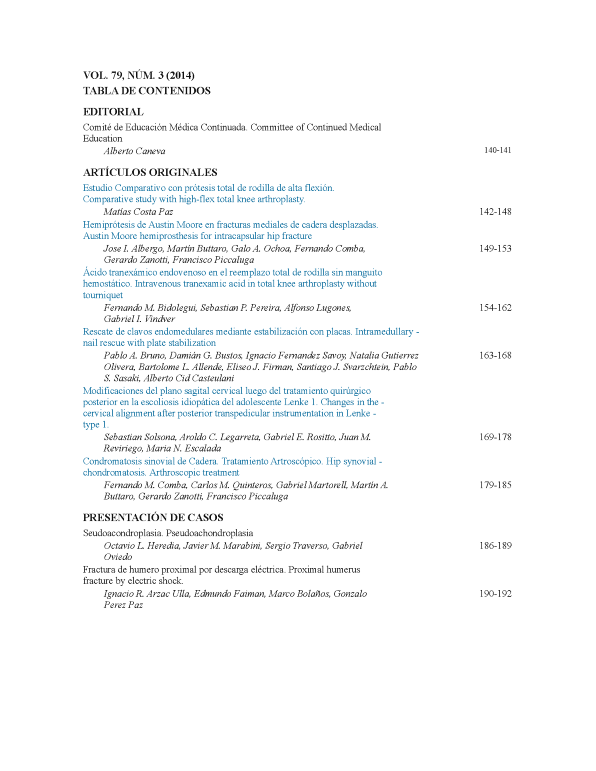Estudio Comparativo con prótesis total de rodilla de alta flexión. [Comparative study with high-flex total knee arthroplasty.]
Contenido principal del artículo
Resumen
Descargas
Métricas
Detalles del artículo

Esta obra está bajo licencia internacional Creative Commons Reconocimiento-NoComercial-CompartirIgual 4.0.
La aceptación del manuscrito por parte de la revista implica la no presentación simultánea a otras revistas u órganos editoriales. La RAAOT se encuentra bajo la licencia Creative Commons 4.0. Atribución-NoComercial-CompartirIgual (http://creativecommons.org/licenses/by-nc-sa/4.0/deed.es). Se puede compartir, copiar, distribuir, alterar, transformar, generar una obra derivada, ejecutar y comunicar públicamente la obra, siempre que: a) se cite la autoría y la fuente original de su publicación (revista, editorial y URL de la obra); b) no se usen para fines comerciales; c) se mantengan los mismos términos de la licencia.
En caso de que el manuscrito sea aprobado para su próxima publicación, los autores conservan los derechos de autor y cederán a la revista los derechos de la publicación, edición, reproducción, distribución, exhibición y comunicación a nivel nacional e internacional en las diferentes bases de datos, repositorios y portales.
Se deja constancia que el referido artículo es inédito y que no está en espera de impresión en alguna otra publicación nacional o extranjera.
Por la presente, acepta/n las modificaciones que sean necesarias, sugeridas en la revisión por los pares (referato), para adaptar el trabajo al estilo y modalidad de publicación de la Revista.
Citas
Traumatol Arthrosc 2007;15:350-5.
2. Coughlin KM, Incavo SJ, Doohen RR, Gamada K, Banks S, Beynnon BD. Kneeling kinematics after total knee arthroplasty:
anterior-posterior contact position of a standard and a high-flex tibial insert design. J Arthroplasty 2007;22:160-5.
3. Huang HT, Su JY, Wang GJ. The early results of high-flex total knee arthroplasty: a minimum of 2 years of follow-up.
J Arthroplasty 2005;20:674 9.
4. Huddleston JI, Scarborough DM, Goldvasser D, Freiberg A, Malchou H. How often do patients with high-Flex total knee
arthroplasty use high flexion? Clin Orthop Relat Res 2009;467:1898-906.
5. Kim YH, Sohn KS, Kim JS. Range of motion of standard and high-flexion posterior stabilized total knee prostheses: a
prospective, randomized study. J Bone Joint Surg Am 2005;87:1470-5.
6. Kim YH, Choi Y, Oh-Ryong K, Kim JS. Functional outcome and range of motion of high-flexion posterior cruciate-retaining
and high-flexion posterior cruciate substituting total knee prostheses. A prospective, randomized study. J Bone Joint Surg Am
2009;91:753-60.
7. Laskin RS. The effect of a high-flex implant on postoperative flexion after primary total knee arthroplasty. Orthopedics 2007;30
(Suppl):86-8.
8. McCalden RW, MacDonald SJ, Bourne RB, Marr JT. A randomized controlled trial comparing “high-flex” vs “standard”
posterior cruciate substituting polyethylene tibial inserts in total knee arthroplasty. J Arthroplasty 2009;24(Suppl):33-8.
9. Mehin R, Burnett RS, Brasher PMA. Does the new generation of high-flex knee prostheses improve the post-operative range of
movement? A meta-analysis. J Bone Joint Surg Br 2010;92:1429-34.
10. Ng FY, Wong HL, Yau WP, Chiu KY, Tang WM. Comparison of range of motion after standard and high-flexion posterior
stabilised total knee replacement. Int Orthop 2008;32:795-8.
11. Weeden SH, Schmidt R. A randomized, prospective study of primary total knee components designed for increased flexion.
J Arthroplasty 2007;22:349-52.
12. Ritter MA, Harty LD, Davis KE, Meding JB, Berend ME. Predicting range of motion after total knee arthroplasty. J Bone
Joint Surg Am 2003;85:1278-85.
13. Nutton RW, van der Linden ML, Rowe PJ, Gaston P, Wade FA. A prospective randomised double-blind study of functional
outcome and range of flexion following total knee replacement with the NexGen standard and high flexion components. J Bone
Joint Surg Br 2008;90:37-42.
14. Seon JK, Park SJ, Lee KB, Yoon TR, Kozanek M, Song EK. Range of motion in total knee arthroplasty: a prospective
comparison of high-flexion and standard cruciate-retaining designs. J Bone Joint Surg Am 2009;91:672-9.
15. Wohlrab D, Ditl J, Herrschelmann R, Schietsch U, Hein W, Hube R. Does the NexGen LPS flex mobile knee prosthesis
offer advantages compared to the NexGen LPS?: a comparison of clinical and radiological results. Z Orthop Ihre Grenzgeb
2005;143:567-72.

